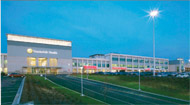|
COVER STORY, JULY 2011
SPACE INVADERS
Non-traditional tenants boost empty retail space.
Savannah Duncan
During the last couple of years, the number of non-traditional tenants leasing retail space has increased. Medical offices, religious organizations and gyms are the most common tenants. However, community uses, like libraries and schools, and entertainment uses, such as miniature golf courses, bowling alleys and indoor theme parks have seen some activity as well.
“We’ve been leasing space for these kinds of uses for more than 20 years,” says Alex Munoz, director of leasing for Atlanta-based The Shopping Center Group. “During the last several years when the supply of retail space has exceeded the demand, leasing space to alternative uses has become an important topic of discussion.”
Medical uses have been among the most popular of the non-traditional tenants. A great example of a medical tenant using retail space in the Southeast is at 100 Oak in Nashville, Tennessee, according to Jeff Green, president of Phoenix-based Jeff Green Partners.
 |
Vanderbilt Health filled 440,000 square feet of empty retail space at 100 Oak in Nashville, Tennessee.
|
|
“100 Oak was a mall that was converted into a hybrid outlet on the second floor with a first floor big box store,” he says. “The big box did fine but the outlets did not work out.” Vanderbilt Health decided to build out part of the 2nd floor, but ended up taking the entire second floor, totaling 440,000 square feet. Patients receive a beeper so they can go shopping while waiting for their appointment. Green reports that sales at the big box retailers have gone up a minimum of 20 percent since the office opened.
Green says that this is one of the only examples of a medical user going into a regional mall as opposed to a strip center.
Jim Thompson, managing director for Jacksonville, Florida-based Regency Centers, has also had success with medical tenants.
“We have a physical therapist [in a center] that 5 or 6 years ago wouldn’t have been high on our list,” he says. “We would have added up retail use to fill the center. Today we put him into a center and have found that the 14,000 shoppers coming through have been very good for his business. We have used him as a testimonial saying ‘It’s good for my business and it’s probably going to be good for yours.’”
Green says, however, that medical users can sometimes raise concern with other tenants because of the need for build-out and parking issues.
“What malls or shopping centers are doing is dedicating parking for medical office use only. You have a problem if those parking spaces are shared between retailers. It would be hard to get those retailers to agree to give up spaces,” he says.
Fitness centers, which have been a widespread, non-traditional tenant, can also highly impact the number of parking spaces, especially in the afternoons and nights.
Rush Fitness has leased several 15,000- to 30,000-square-foot spaces at indoor malls in the Southeast, says Munoz. A larger example is a 46,820-square-foot LA Fitness, which recently joined Regency Centers’ Marketplace Shopping Center in St. Petersburg, Florida, according to Thompson.
Community uses are important to Denise Browning, senior vice president of Madison Marquette’s Charlotte, North Carolina, office, because she says it creates good will in the community.
Madison Marquette has recently started a temporary tenant program that leases retail space on a short-term basis. Browning says that non-traditional tenants are filling many of these spaces.
“In University Mall in Chapel Hill, North Carolina, we’ve got KatieBeth’s Learning Garden, which is a resource for home-schooled children,” she says. “We are also very excited to host the public library while their facility undergoes an 18-month renovation. It is one of the highest traffic per capita libraries in the state so that will force about 1,200 people a day to walk through our mall.”
While some alternative tenants, like religious and entertainments uses, might not have the high rent others do, they can be huge traffic draws for retail centers and malls.
Browning says that in at The Monroe Crossings in Monroe, North Carolina, an indoor play place called Xtreme Play leased 10,000 square feet at a space that hadn’t been leased in 10 years. Parents can drop of children over the age of five for up to two and a half hours of shopping time.
“It is a great traffic generator,” she says. “Xtreme Play will probably never be a great rent generator, but the traffic [brought to the center] is really key.”
Non-traditional tenants are taking advantage of the empty big box space to expand to new markets. One example is Monster Mini Golf, which has about 25 locations currently and is expanding at the rate of six to eight new openings a year in strip centers.
“We want to be in an easy-to-get-to location,” says Christina Vitagliano, founder of Monster Mini Golf. “One of the good things about the economy being down is that there are a lot of empty stores. We’re finding [these locations] working really well and we’re drawing families to the plaza, so that makes a difference for everybody.”
Until the retail market has recovered in full, non-traditional tenants are here to stay. “Alternative retailers are a good, clean use that we see as a viable service sector we would like to see in our centers,” says Thompson. “If we developed a new shopping center, from a clean-slate merchandising plan you would see some of those uses.”
Browning agrees. “There’s always a couple of spaces in every project that are really tough to lease,” she says. “Our goal is to get real retail tenants in there, but there will always be some space for these alternative uses.”
©2011 France Publications, Inc. Duplication
or reproduction of this article not permitted without authorization
from France Publications, Inc. For information on reprints
of this article contact Barbara
Sherer at (630) 554-6054.
|
